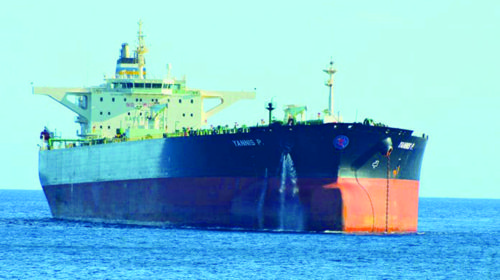…as 1M barrels of oil depart Guyana for the US

The first million barrels of Guyana’s oil has been lifted, loaded and has departed Guyana’s shores, with the Energy Department confirming that representatives of Guyana National Bureau of Standards (GNBS) and the Guyana Revenue Authority (GRA) were on hand to scrutinise the process.
In a statement on Tuesday, the Department of Energy announced that oil tanker MV Yannis departed for the US with Exxon’s share of the oil. It had previously been announced that when oil production starts, the first lift would go to Exxon.
There had been concerns, however, as to who would observe the process to ensure Exxon took the right amount of oil. The Energy Department confirmed in its release that the Guyana National Bureau of Standards (GNBS) independently verified the amounts.
“The GNBS has reported that the first offloading of crude oil on the FPSO commenced on the morning of Saturday, January 18, 2020, and all activities were executed as planned. The Guyana National Bureau of Standards is responsible for independently ensuring the accurate measurement of Guyana’s oil from the Stabroek Block,” the release said.
The Department also cited the Guyana Revenue Authority (GRA) for its role in the process. It added that moving forward, lifts are expected approximately every 10 to 12 days. Guyana has an arrangement where its first three lifts will be sold to Shell.
“This first lift due to the record set from discovery to production by the operator, sets Guyana firmly on its way to becoming one of the wealthiest countries on the globe per capita, according to many industry specialists,” the Department said.
“Already, the sector has witnessed foreign direct investment (FDI) in excess of US$500 million, the creation of over 1700 direct jobs, over 600 service providers, and the establishment of over 70 joint ventures, alliances and partnerships which continue to increase. Oil revenues from this venture alone are projected to realise approximately US$300 million in this first year and more than tripling over the next 5 years.”
The crude tanker was built in 2010. ExxonMobil’s Public and Government Affairs Advisor, Janelle Persaud had said on Friday that ExxonMobil will process the cargo in its own refining system as was previously announced.
On December 20, 2019, United States oil giant ExxonMobil announced the commenced production of Guyana’s oil in the Stabroek Block, where 15 discoveries of crude in commercial quantities have been made since 2015.
In September 2019, the Liza Destiny floating production, storage and offloading vessel (FPSO) arrived in Guyana’s waters. The vessel is a significant component of the Liza Phase One Development, which involves four undersea drill centres with 17 production wells.
Besides its production capacity of 120,000 barrels of oil per day, it also has an overall storage volume of 1.6 million barrels.
During normal operations, there will be at least 80 persons living and working onboard the vessel.
With the 120,000 barrels expected daily from production in the Liza Phase One Development, it is estimated that Guyana will earn some US$300 million annually.
ExxonMobil had previously said there is potential for at least five FPSO vessels in the Stabroek Block, producing more than 750,000 barrels of oil per day by 2025. Liza Phase Two Development is expected to start-up by mid-2022. It had been reported that the project would use the Liza Unity FPSO to produce up to 220,000 barrels per day.
With Hess Guyana Exploration Ltd holding 30 per cent interest in the Stabroek Block, ExxonMobil’s affiliate, Esso Exploration and Production Guyana Limited (EEPGL) has 45 per cent interest and is also the operator of the 6.6 million acres block while CNOOC Petroleum Guyana Limited, a wholly-owned subsidiary of China’s state-owned CNOOC Limited, holds the remaining 25 per cent interest.



